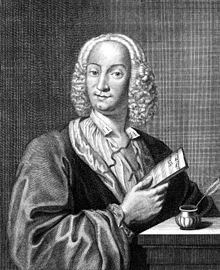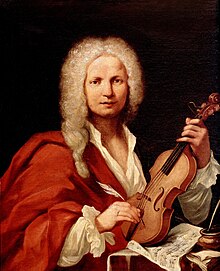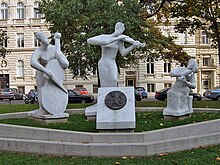Antonio Vivaldi
Antonio Lucio Vivaldi (* 4. March 1678 in Venice ; † 28. July 1741 in Vienna ) was a Venetian composer , violinist of the Baroque and Roman Catholic priests .
Live and act
childhood
Vivaldi's father Giovanni Battista Vivaldi came to Venice from Brescia at the age of ten , where he was initially a barber like his father and later became a professional violinist . His marriage to Camilla Calicchio, the daughter of a tailor, whom he married on June 11, 1676, had ten children. The second-born son Antonio (the eldest sister Gabriela Antonia had already died in infancy) was allegedly born during an earthquake and was emergency baptized (whether this was because of the catastrophe or whether his later health problems became apparent is unknown).
In 1685 his father got a job as a violinist at St. Mark's Basilica ; he enjoyed a good reputation as a musician, as a member of the Cäcilienverein had diverse connections within the Venetian musical life and was mentioned in a travel guide as a violin virtuoso worth listening to . Antonio became the only professional musician among his siblings. He showed his musical talent on the violin at an early age and is said to have represented his father in the orchestra in his youth. He could have received music theory lessons from Giovanni Lenzei , who died in 1690 when Antonio Vivaldi was only twelve years old.
Priest and music teacher
At the age of 15, Antonio received the tonsure and the first minor ordination , which, according to the custom at the time, was not associated with a decision for the priesthood, but the goal of a higher social status. The decision for the clerical status was made - more or less binding - when he received the first major ordination as subdeacon at the age of 18 . He completed his training as a priest , less a study of theology than a professional training, in two nearby parishes .
At the age of 25 he was ordained a priest - only one year later than the earliest possible under canon law . He then became chaplain at the Church of Santa Maria della Pietà and, at the request of Francesco Gasparini, violin teacher at the Ospedale della Pietà , an orphanage for girls affiliated to this church . He read masses there for a year and a half. Then he gave up the priesthood forever, which he justified in a much later letter with health problems; he writes of strettezza di petto , ie “tightness of the chest”, which should indicate angina pectoris or perhaps asthma .
As can be seen from the pay slips of the Ospedale della Pietà, after a short time he was not only employed as a violin teacher, but also as a teacher for cello and viola d'amore (viola all'inglese). An anecdote shows that he also played the harpsichord .
Because of his hair color inherited from his father Giambattista (referred to as Rossi or Rossetto ), he was called Il Prete Rosso ("the red priest").
Violin concertos for the girls' orchestra
Vivaldi looked after the orchestra of the Ospedale della Pietà (one of four homes in Venice for orphan girls), from 1703 as maestro di violino , from 1704 additionally as maestro di viola all'inglese . He held the post of instrumental teacher until 1716 (with an interruption from February 1709 to September 1711), then he was appointed musical director (maestro de 'concerti) . The orchestra soon gained a legendary reputation for the time and attracted numerous travelers to Italy. Most of its numerous violin concertos and sonatas were written for the Ospedale . They were played in the church services. Of these, 30 violin concertos were written for the violinist Anna Maria , his student and later colleague at the Ospedale della Pietà .
After two sonata collections printed in Venice (12 trio sonatas op. 1, printed in 1705, and 12 violin sonatas, op. 2, printed in 1709), Vivaldi's concert collection L'estro armonico (for example: “The harmonic inspiration”) op. 3 (printed in 1711 ) a European celebrity. By 1729 a total of 12 collections had appeared, all of which were printed by Estienne Roger in Amsterdam from op. 3 onwards. The twelve concerts op. 8 (printed in 1725) Il cimento dell'armonia e dell'invenzione (for example: “The Contest between Harmony and Invention”) contain the famous Le quattro stagioni (The Four Seasons) as the first four concerts .
Opera composer and artistic director in Venice and Mantua
Vivaldi began composing operas while he was employed at the Ospedale della Pietà. Starting with Ottone in villa , which premiered in Vicenza in 1713 , over fifty more operas were to follow by 1739. In addition to his employment at the Ospedale della Pietà, Vivaldi increasingly took on the role of impresario at the Venetian Teatro Sant'Angelo . On the occasion of the Venetian Turkish War , Vivaldi composed a patriotic oratorio Juditha triumphans in 1716 , the material of which is taken from the book Judit .
After disputes in Venice, he moved to Mantua in 1718 , where he mainly worked as artistic director and opera composer in the service of Prince Philipp von Hessen-Darmstadt . After 1721 he stayed in Rome several times , played twice for the Pope and received many commissions for opera and church music .
In 1726 he returned to his hometown Venice as musical director of the Teatro Sant'Angelo. There he became a living legend both as a composer and as a violin virtuoso and a “pilgrimage destination” for many musicians from all over Europe. Around this time he also got to know the then 16-year-old Anna Girò , a singer of French origin (originally Giraud), who from then on accompanied him on his travels. Between 1729 and 1733 Vivaldi visited numerous northern Italian cities ( Verona , Ancona , Reggio and Ferrara ) and was probably also in Prague , where two of his operas were premiered.
Trip to Vienna
Around 1730 a change in musical taste began. Vivaldi's compositions appealed less and less to the Venetian audience. This is probably why he moved to Vienna in 1740 to seek support from Emperor Karl VI. who died in October 1740. The once best-known musician in Europe went unnoticed by the music world in Vienna.
Vivaldi died ten months after his arrival in Vienna and was buried on July 28, 1741 in a simple grave on the Spitaller Gottsacker in front of the Kärntnertor, where the main building of the Technical University of Vienna ( Karlsplatz ) is today. There is a memorial plaque for him there. In 1972 Vivaldigasse in Vienna- Favoriten was named after him.
music
Of Vivaldi's almost 500 concertos, 241 have been preserved for violin as a solo instrument . In second place are 39 bassoon concertos . The other concerti are for various woodwind instruments , 27 for violoncello , but also for more unusual instruments such as viola d'amore or mandolin . In an operatic aria he even used a salterio (Italian baroque chopping board). According to the convention - with the exception of the six flute concertos op. 10 - all published concert collections require one or more solo violins. Around 70 concerts are for two or more soloists, some of which with their unusual instrument combinations - in the RV 555 concert the solo group is even expanded to 16 soloists - show Vivaldi's pronounced sense of sound and experimentation.
Vivaldi brought up the solo concerto as a major form of the high baroque , and he helped three-movement works to break through. In the quick corner movements he systematically used the ritornello form for the first time , in which the orchestra repeats a musical passage several times and alternates with solo sections that have a freer, more episodic character and contain modulating passages. His slow middle movements are characterized by cantilenas on the solo instrument.
In addition, around 55 ripieno concerts (concerts without soloists) and around 21 chamber concerts (concerts for soloists without orchestra) document intensive experimentation with the concert form. Vivaldi's 49 operas identified so far were gradually developed from the 1970s onwards and played at festivals or produced for CDs. Most of your scores or remnants of old sheet music are kept in the Biblioteca Nazionale in Turin.
After two centuries of oblivion, Vivaldi's extensive spiritual work is also attracting attention again. Often the same lively, virtuoso style and a similar willingness to experiment as in his solo concerts can be found here. His Gloria for two sopranos, alto and four-part choir is particularly well known . He wrote several versions of the Magnificat .
Vivaldi was not only very influential in northern Italy, but also in Germany. After his trip to Italy, Johann Georg Pisendel spread Vivaldi's techniques at the Dresden court. Johann Sebastian Bach's style went through a profound development under the influence of Vivaldi; among other things , Bach transcribed several concerts for harpsichord and for organ.
Contemporary prints
Opus 1 to 12
The following works were published during Vivaldi's lifetime and mostly in Amsterdam. It can be assumed that most of these works were created within a period of up to ten years before printing.
- Op. 1: 12 Triosonaten da camera for 2 violins and continuo (1705)
- Op. 2: 12 sonatas for violin and basso continuo (1709)
- Op. 3: 12 violin concertos L'estro armonico , for 1–4 solo violins and orchestra (1711)
- Op. 4: 12 violin concertos La stravaganza (1712)
- Op. 5: 6 sonatas for 1 or 2 violins (1716)
- Op. 6: 6 violin concertos (1716)
- Op. 7: 12 violin and oboe concertos (1717)
- Op. 8: 12 violin concertos Il cimento dell'armonia e dell'inventione (1725), therein: The four seasons
- Op. 9: 12 violin concertos La cetra (1727)
- Op. 10: 6 flute concertos (1728)
- Op. 11: 6 violin and oboe concertos (1729)
- Op. 12: 6 violin concertos (1729)
Fake Opus 13
Earlier, a collection of sonatas entitled Il pastor fido (printed in Paris in 1737) was ascribed to Vivaldi and published as Op. 13: 6 sonatas for a soprano instrument and basso continuo. Due to the French style elements, Vivaldi's authorship has been in doubt since the 1970s at the latest. A document by the Parisian composer and publisher Jean-Noël Marchand (1700–1781) discovered in 1990 then provided evidence that the sonatas were written by Marchand's distant relative Nicolas Chédeville . In some cases, however, Chédeville used themes from various printed works published under Vivaldi's name.
Rediscovery of lost works
Vivaldi's music was soon forgotten. It wasn't until the beginning of the 20th century that people began to be more interested in Vivaldi. In 1926, Salesian monks from Montferrat finally offered a musical collection from the Turin National Library for sale. One reviewer found that 97 volumes of Vivaldi's music - mostly autograph scores - contained twelve operas, 29 cantatas and 140 instrumental works. The collection was bought a year later. On closer inspection it was found that the volume count showed gaps, so it was only about half of a larger collection. The second part was soon found in the nephew of the Marquis Marcello Durazzo , and so the collection was reunited in 1930. The acquisitions were financed with the help of Roberto Foà and Filippo Giordano, which is why the Turin manuscripts are also called Raccolta Foà-Giordano (Italian: raccolta "collection").
Most of Vivaldi's compositions were rediscovered in 1930. Up to the present day, however, new works keep appearing, around 1973 a collection of twelve partly autograph sonatas in Manchester. Also worth mentioning are several psalm finds in Dresden in 1991, 2003 and 2005 by Peter Ryom and Janice Stockigt .
Catalog raisonnés
Already Johann Gottfried Walther or Ernst Ludwig Gerber took in the 18th century to attempt to list Vivaldi's works. Mario Rinaldi ( RN or op. ) Undertook the first somewhat systematic list of works in 1943 and 1945. In 1948, Marc Pincherle ( P , PS or PV for Pincherle directory) published a list of Vivaldi's instrumental works, which, however, changed through ongoing research and the The appearance of further works soon proved to be incomplete. In 1968 Antonio Fanna ( F ) also wrote a list of instrumental works, mainly 530 works published by Ricordi . The Danish musicologist Peter Ryom (* 1937) finally published an updated catalog raisonné in 1973 (German 1974), the so-called Ryom catalog ( RV ). This prevailed over the others today. An expanded version was published in 2007.
Eponyms
The asteroid (4330) Vivaldi , discovered on October 19, 1982, was named after him in 1990. He has been the namesake of the Vivaldi Glacier on Alexander I Island in Antarctica since 1979 .
See also
literature
- Theophil Antonicek , Elisabeth Hilscher: Vivaldi. Academic Printing and Publishing Company, Graz 1997, ISBN 3-201-01677-2 .
- Hans-Günter Klein : The influence of the vivaldic concert form in the instrumental work of Johann Sebastian Bach with examples of music and tables (= collection of musicological treatises (Valentin Koerner GmbH), vol. 54). Strasbourg; Baden-Baden: Heitz, 1970.
- Michael Lorenz : Haydn Singing at Vivaldi's Exequies: An Ineradicable Myth. (Vienna 2014).
- Siegbert Rampe : Antonio Vivaldi and his time. Laaber-Verlag, Laaber 2010, ISBN 978-3-89007-468-9 .
- André Romijn: Hidden Harmonies. The Secret Life of Antonio Vivaldi. Roman House Publishers, Ripon 2008, ISBN 978-90-8662-009-8 .
- Peter Ryom: Antonio Vivaldi. Thematic-systematic index of his works (RV). Breitkopf & Härtel, Wiesbaden et al. 2007, ISBN 978-3-7651-0372-8 .
- Peter Ryom : Directory of Antonio Vivaldi's works. (RV). Small edition. VEB German publishing house for music, Leipzig 1974 ( Ryom directory ).
- Josef Johannes Schmid : Vivaldi, Antonio Lucio. In: Biographisch-Bibliographisches Kirchenlexikon (BBKL). Volume 14, Bautz, Herzberg 1998, ISBN 3-88309-073-5 , Sp. 1586-1589.
- Peter Schneider : Vivaldi and his daughters. Novel of a life. Kiepenheuer & Witsch, Cologne 2019, ISBN 978-3-462-05229-9 .
- Michael Stegemann: Vivaldi (= Rowohlt's monographs. Vol. 338). Rowohlt, Reinbek near Hamburg 1985, ISBN 3-499-50338-7 .
- Michael Talbot : Vivaldi (= BBC Publications = BBC Music Guides ). British Broadcasting Corporation, London 1979, ISBN 0-563-12856-9 .
- Michael Talbot: Antonio Vivaldi. A Guide to Research (= Garland Composer Resource Manuals. Vol. 12 = Garland Reference Library of the Humanities. Vol. 757). Garland Press, New York NY et al. 1988, ISBN 0-8240-8386-5 .
- Sebastian Zips: The Violoncello Sonatas by Antonio Vivaldi. Eichstätt 2005 (dissertation at the University of Eichstätt-Ingolstadt, 2005).
Web links
- Works by and about Antonio Vivaldi in the catalog of the German National Library
- Works by and about Antonio Vivaldi in the German Digital Library
- Detailed CV Vivaldis u. Catalog raisonné by RV (Ryom), Fanna, Opus, genre and title
- Vivaldi's catalog raisonnés after Ryom (RV), Fanna, Pincherle, Ricordi, Opus and Instrumentation (English)
- Antonio Vivaldi's work directories according to RV (Ryom directory) and all known directories (French)
- Information on the court music project of the Saxon State and University Library Dresden (with references to the digitized manuscripts of the Pisendel collection available on the Internet, including autographs and copies of Vivaldi's instrumental works)
- Antonio Vivaldi in the Bavarian Musicians' Lexicon Online (BMLO)
Online scores
- Vivaldi sheet music and audio files in the International Music Score Library Project
- Sheet music in the public domain by Antonio Vivaldi in the Choral Public Domain Library - ChoralWiki (English)
- Works by Antonio Vivaldi in the Mutopia project
- Magnificat (Cantory Archive)
Individual evidence
- ^ Michael Talbot : The Vivaldi Compendium. The Boydell Press, Woodbridge 2011, ISBN 978-1-84383-670-4 , p. 3.
- ↑ See title pages to op. X and XII: … SAS Il Sig'r Principe Filippo Langravio d'Hassia Darmstadt.
- ↑ This work was published on April 17, 1737 by the Paris publisher M. Boivin under the following title: "Il Pastor Fido" pour la Musette, Vièle, Flûte, Hautbois, Violon, avec la Basse Continue, del Sig'Antonio Vivaldi, opera XIII / Avec le privilège du roi.
- ↑ Cf. Federico Maria Sardelli: Vivaldi's Music for Flute and Recorder. Ashgate, Aldershot (UK) 2007, p. 77 f.
- ↑ See Peter Ryom: Antonio Vivaldi. Thematic-systematic index of his works (RV). Breitkopf & Härtel, Wiesbaden 2007, p. 571.
- ↑ Arnold Schering dealt with Vivaldi's music in his History of the Instrumental Concerto in 1905.
- ↑ Michael Talbot: Antonio Vivaldi. The Venetian and Baroque Europe. Life and work. DVA , Stuttgart 1985, p. 17.
- ↑ Michael Talbot: Antonio Vivaldi. 1985, p. 18.
- ↑ Manoscritti Vivaldiani nelle Raccolte Foà e Giordano
- ↑ Michael Talbot: Antonio Vivaldi. 1985, p. 11.
- ↑ Janice Stockigt: Discover Vivaldi. A find and its history. (PDF; 90 kB) SLUB-Kurier , 2006/1
- ↑ All information in this section comes from: Peter Ryom: Directory of Antonio Vivaldi's works. Small edition. Deutscher Verlag für Musik, Leipzig 1974, pp. 213–217.
- ↑ Minor Planet Circ. 16045
| personal data | |
|---|---|
| SURNAME | Vivaldi, Antonio |
| ALTERNATIVE NAMES | Vivaldi, Antonio Lucio; Il prete rosso |
| BRIEF DESCRIPTION | Italian composer |
| DATE OF BIRTH | March 4, 1678 |
| PLACE OF BIRTH | Venice |
| DATE OF DEATH | July 28, 1741 |
| Place of death | Vienna |





